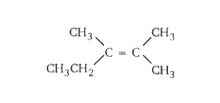Compound 'X' give following reactions
X(C_(6)H_(8)O_(2)) "GRB_HP_JEE_ORG_CHE_C11_E01_007_Q01.png" width="80%">
Its structure can be :




The correct Answer is:C
To determine the structure of compound 'X' (C₆H₈O₂) based on the given reactions, we will follow these steps:
Step 1: Calculate the Double Bond Equivalent (DBE)
The formula for calculating the Double Bond Equivalent (DBE) is:
DBE=C−H2+N2+1
Where:
- C = number of carbon atoms
- H = number of hydrogen atoms
- N = number of nitrogen atoms (not applicable here)
For compound 'X':
- C=6
- H=8
Calculating DBE:
DBE=6−82+1=6−4+1=3
Step 2: Analyze the Possible Structures
We need to check the given options to see which one has 3 double bond equivalents. The options are:
- Option A: Contains a ring and two double bonds (3 DBE)
- Option B: Contains two double bonds (2 DBE)
- Option C: Contains a ring and two double bonds (3 DBE)
- Option D: Contains three double bonds (3 DBE)
Step 3: Identify Acidic Hydrogen
Next, we check which of the structures can release hydrogen gas when reacted with sodium metal, indicating the presence of acidic hydrogen (like in carboxylic acids).
- Option A: Contains acidic hydrogen
- Option B: No acidic hydrogen
- Option C: Contains acidic hydrogen
- Option D: Contains acidic hydrogen
Step 4: 2,4-Dinitrophenylhydrazine (2,4-DNP) Test
The 2,4-DNP test identifies carbonyl groups (C=O). We need to find out which options contain a carbonyl group:
- Option A: Contains an aldehyde (positive test)
- Option B: No carbonyl group (negative test)
- Option C: Contains a ketone (positive test)
- Option D: Contains a ketone (positive test)
Step 5: Ozonolysis Reaction
The ozonolysis reaction will help us determine the structure based on the products formed:
- Option C: If ozonolysis occurs, it will yield a single molecule with 6 carbons.
- Option D: Ozonolysis will yield two different products, indicating it does not correspond to a single compound.
Conclusion
Based on the analysis:
- Option C is the correct structure for compound 'X' since it satisfies all the conditions: it has 3 DBE, contains acidic hydrogen, has a carbonyl group, and yields a single product upon ozonolysis.
Final Answer
The structure of compound 'X' is represented by Option C.
---
The formula for calculating the Double Bond Equivalent (DBE) is:
DBE=C−H2+N2+1
Where:
- C = number of carbon atoms
- H = number of hydrogen atoms
- N = number of nitrogen atoms (not applicable here)
- C=6
- H=8
DBE=6−82+1=6−4+1=3
We need to check the given options to see which one has 3 double bond equivalents. The options are:
- Option A: Contains a ring and two double bonds (3 DBE)
- Option B: Contains two double bonds (2 DBE)
- Option C: Contains a ring and two double bonds (3 DBE)
- Option D: Contains three double bonds (3 DBE)
Next, we check which of the structures can release hydrogen gas when reacted with sodium metal, indicating the presence of acidic hydrogen (like in carboxylic acids).
- Option A: Contains acidic hydrogen
- Option B: No acidic hydrogen
- Option C: Contains acidic hydrogen
- Option D: Contains acidic hydrogen
The 2,4-DNP test identifies carbonyl groups (C=O). We need to find out which options contain a carbonyl group:
- Option A: Contains an aldehyde (positive test)
- Option B: No carbonyl group (negative test)
- Option C: Contains a ketone (positive test)
- Option D: Contains a ketone (positive test)
The ozonolysis reaction will help us determine the structure based on the products formed:
- Option C: If ozonolysis occurs, it will yield a single molecule with 6 carbons.
- Option D: Ozonolysis will yield two different products, indicating it does not correspond to a single compound.
Based on the analysis:
- Option C is the correct structure for compound 'X' since it satisfies all the conditions: it has 3 DBE, contains acidic hydrogen, has a carbonyl group, and yields a single product upon ozonolysis.
The structure of compound 'X' is represented by Option C.
Similar Questions
Calculate the angles x,y and z if
x3=y4=z5
(##SEL_RKB_ICSE_MAT_X_C17_E02_042_Q01.png" width="80%">
View SolutionConsider the following three amines,
(1) CH_(3)CH_(2)-ddot(N)H_(2)" (2) "CH_(2)=CH-ddot(N)H_(2)" (3) "(##GRB_HP_JEE_ORG_CHE_C01_E01_081_Q01.png" width="80%">
Arrange C-N bond length of these compounds in decreasing order :
View Solution
Knowledge Check
What,is the major product ofthe following reaction?
(##BLJ_MSC_OBJ_CHE_JEE_C05B_E01_057_Q01.png" width="80%">A B
B C
C D
D
Consider the following :
" "underset((I))(CH_(3)CH_(2)NH_(2))," "underset((II))(CH_(3)overset(overset(O)(||))(C)NH_(2))," "(##GRB_HP_JEE_ORG_CHE_C01_E01_028_Q01.png" width="80%">
Correct order of their basic strength is :AI<II<IIIBII>I>IIICIII<II<IDII<III<IArrange the following carbanions in decreasing order of stability :
" "underset((P))(CH_(2)=overset(ө)(C)H)" "underset((Q))(Ph-overset(ө)(C)H_(2))" "underset((R))(CH_(2)=CH-overset(ө)(C)H_(2))" "(##GRB_HP_JEE_ORG_CHE_C01_E01_099_Q01.png" width="80%">AP>Q>R>SBS>Q>P>RCS>Q>R>PDQ>S>R>P
Identify number of chiral carbons in the following compounds.
H3c−CH∣OH−CH∣OH−CH2∣OH (II)(##GRBHPJ∃ORGCHEC02E01027_Q01.png width=80%><br>(IIII)H_(3)C- underset(CH_(3)) underset(|)(CH)-underset(CH_(3)) underset(|)(CH)-CH_(2)-CH_(3)
View SolutionArrange the following acids in decreasing order of acidity :
underset((X))(H-overset(overset(O)(||))(C)-OH)" "underset((Y))(CH_(3)-overset(overset(O)(||))(C)-OH)" "(##GRB_HP_JEE_ORG_CHE_C01_E01_118_Q01.png" width="80%">
View SolutionThe decreasing order of nucleophilicity among the nucleophiles is :
(I) CH3−C∣∣OO− (III) CH3O−
(III) CH^(-)" (IV) "(##GRB_HP_JEE_ORG_CHE_C01_E01_026_Q01.png" width="80%">
View SolutionThe given image represents:
(##OSW_GRU_MCQ_ISC_XII_SM1_BIO_C05_E01_070_Q01.png" width="80%">
View SolutionMatch the items of column A to those given in column B.
(##OSW_GRU_MCQ_ISC_XII_SM1_CHE_C01_E01_039_Q01.png" width="80%">
View Solution